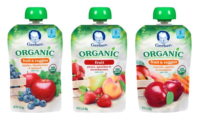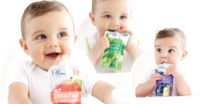When it comes to baby food, today’s parents seem to be primarily concerned that the product is healthful, organic and sustainable. Those same concerns apply to baby food packaging.
Perhaps that’s the reason why pouches are becoming so popular in this segment. Since their introduction in 2008, pouches have taken the world of baby food by storm. They are convenient, sterile and tout a variety of flavors and food combinations. Pouches are easy to use and give flexibility to parents, offering portable nutrition that fits the busy lifestyles many families have today. They also promote self-feeding and independence.
For instance, Happy Family Organics — the largest and fastest growing organic baby food brand in the U.S. — recently announced a new product line, Happy Baby Organics Regenerative & Organic baby food. This new line for ages 6+ months is made with ingredients grown using regenerative farming practices that can help to mitigate climate change by building healthy soil that captures carbon from the atmosphere.
At the same time, Gerber, a well-known name in baby foods, announced a first-of-its-kind, single-material baby food pouch designed for the future of recycling. Developed in partnership with Gualapack, a leader in premade spouted pouches, this is the latest initiative in Gerber’s journey to make 100% of its packaging recyclable or reusable by 2025. It is also an important milestone in creating a wider market for recycled plastics that are safe for food.
Gerber Pouch Uses Single Material
“Designing with a single material creates greater value for the recycling industry, promoting the development of better recycling infrastructure,” says Tony Dzikowicz, asociate director of packaging at Gerber, “After more than two years of experimenting and innovating, we were able to help create a first-of-its-kind solution for baby food that meets the safety and freshness requirements for our little ones.”
With Nestlé as a founding member of Materials Recovery for the Future (MRFF), a research collaborative committed to creating recycling solutions, Gerber is helping to expand curbside recycling for the pouch — and all baby food pouches. MRFF’s pilot program in Pottstown, Penn., is now the first curbside recycling program in the U.S. to accept flexible plastics such as these.
“We believe the baby food industry should help create a world where babies thrive, and initiatives like this one help us go beyond nutrition to protect the planet,” said Gerber President and CEO Bill Partyka. “We’re committed to making 100% of our packaging recyclable or reusable by 2025, and this pouch is an important step in promoting the development of better recycling infrastructure.”
The pouch will be available exclusively on TheGerberStore.com for Gerber’s Organic Banana Mango Puree beginning in May 2020, with expansion in product offerings to follow. The pouch will be 100% recyclable through Gerber’s national recycling program with TerraCycle, a social enterprise on a mission to eliminate the idea of waste.
Gerber’s sustainability efforts go beyond packaging, with a focus on reducing energy use, water use and carbon emissions in its factories, and upholding some of the industry’s strongest agricultural standards through its Clean Field Farming practices. Gerber is also continuing to expand its USDA Certified Organic product lines.
Brand On A Mission
As a brand on a mission to change the trajectory of children’s health through nutrition, Happy Family Organics knows that only a healthy planet can grow healthy food. The brand will use its scale as a market leader to accelerate regenerative agriculture in the baby food category.
Regenerative agriculture is a holistic set of farming practices that protects the soil, promotes biodiversity and — when practiced at scale — helps reverse climate change through carbon sequestration in the soil. Studies found that increasing carbon in soils on farms by less than 1% could offset the billion tons of CO2 emitted annually.
“Climate change is one of the biggest existential crises our world is facing, and our children are at the greatest risk. As parents ourselves, we believe we need to act urgently and impactfully to do our part to help reverse climate change and cultivate a more sustainable world for our children to inherit,” says Anne Laraway, CEO of Happy Family Organics. “Regenerative agriculture practices are part of that solution.”
Happy Family is packaging its baby food in pouches pictured on this month’s cover. While pouches aren’t recyclable yet in municipal and curbside systems, Happy Family Organics is working hard to change that.
The Regenerative & Organic line of baby food pouches will be recyclable through Happy Family Organics’ take-back program with TerraCycle, in support of the brand’s pledge to make 100% packaging of its packaging reusable, recyclable or compostable by 2025. Consumers can participate by visiting www.terracycle.com/en-US/brigades/happy-family-organics, where they can request a free recycling envelope for pouches, as well as flexible plastic packaging, and caps.
A few years ago, Happy Family’s line of Clearly Crafted foods were packaged in transparent baby food pouches so parents could see what they were feeding their children. At the time, Happy Family noted that Clearly Crafted products had a shelf life of 10 months, which is shorter than the core line of Happy Family pouches, which takes into account possible light exposure.
A Booming Market
The global baby food packaging market was valued at $76.76 billion in 2019 by Mordor Intelligence, and it is expected to reach $115.17 billion by 2025, registering a CAGR of 6.95% through the forecast period, 2020-2025.
While the United States is a mature market for baby food, developing countries across the world are witnessing rapid urbanization that is leading to increased disposable income and adoption of a modern lifestyle. These factors have led to an increase in the expenditure on baby food products. Another factor boosting the need for novel packaging solutions is the innovations by baby food manufacturers to meet the consumers’ various needs. This has led companies to create green, innovative, and recyclable products to replace normal packaging.
Until the arrival of pouches, baby food had been sold primarily in jars since 1931. Economic and eco-friendly jars have a longer shelf-life (around 2 years) than in pouches (approximately 1 year). And, of course, glass jars allow you (and your child) to see what’s inside.
Pouches Prove Convenient
When pouches first debuted within the U.S. baby food category, Euromonitor says, they attracted attention due to their novel style within the category and the promise to greatly increase convenience for parents presented with the steep challenge of feeding their young ones. In spite of this attention and the clear usefulness presented by the new packaging, questions remained as to how disruptive a force pouches could actually be within a category replete with well-established pack types, such as glass jars and thin-wall plastic containers, that had been intimately familiar to U.S. parents for generations.
However, pouches began to gain favor soon after their introduction. Light and travel-friendly, pouches offer great convenience. Because they are often resealable, unused portions can be stored for later use. Pouches also allow toddlers to feed themselves by squeezing directly from the pouch.
According to a recent Technavio report, one of the key drivers for the global baby food packaging market is the increase in the demand for pouch packaging. Owing to the increase in convenience, safety and sustainability, flexible packaging such as spout pouches are becoming popular in the baby food packaging segment. Stand-up pouches and spout bags are becoming very popular as they have several advantages over traditional packaging.
“The manufacturing of pouches is easy and less time consuming when compared with other packaging material,” according to a senior research analyst at Technavio. “Additionally, the pouches can be printed with any color, logo or design. This reduces the overall manufacturing cost as there is a decrease in the printing cost. Besides, printing on pouches is easier as they have a clear surface. This helps in creating brand awareness by promoting the product by providing clear information.”
Three Types of Pouches
There are basically three types of pouches in use for baby food: stand-up pouches, three-side seal flat bags and spouted stand-up pouches. Barrier bags or pouches for baby food are made from multiple layers of laminated barrier film, this film is made specifically to lock in freshness and protect from moisture, vapor, odor and even puncture. Further, this type of packaging can be printed with as many as 12 colors and requires only a 5,000-piece minimum run, far less than any other type of baby food packaging.
The stand-up pouch continues to be a popular choice for baby food. The wide face and back and the bottom gusset area provide generous amounts of printable space to promote the product and build a brand. This style of barrier bag can work for single serve and multiple serving sizes.
The three-side seal flat pouches for baby food are perfect for single servings. The same laminated film will protect the contents and can be printed with up to 12 colors.
The most popular type of baby food packaging today are the spouted stand-up pouches with a spout and cap inserted and sealed to a pouch. Most products that use a spouted stand-up pouch are wet or semi liquid. The spout allows for easy pouring or a toddler can suck the product directly from the pouch.




